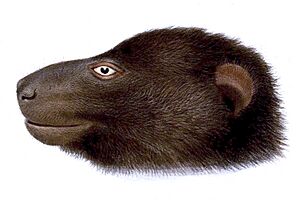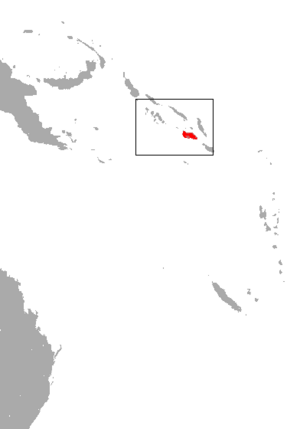Guadalcanal monkey-faced bat facts for kids
Quick facts for kids Guadalcanal monkey-faced bat |
|
|---|---|
 |
|
| Conservation status | |
| Scientific classification | |
| Genus: |
Pteralopex
|
| Species: |
atrata
|
 |
|
| Guadalcanal monkey-faced bat range | |
The Guadalcanal monkey-faced bat, also called the Guadalcanal flying monkey (Pteralopex atrata), is a type of megabat found only in the Solomon Islands. It is an endangered species, meaning it is at high risk of disappearing forever. In 2013, Bat Conservation International chose this bat as one of 35 top priority species to help protect around the world.
Contents
About the Guadalcanal Monkey-faced Bat
This bat was the very first of its kind, the monkey-faced bats, to be officially described by scientists. A British zoologist named Oldfield Thomas described it in 1888. He based his description on a bat collected by another British naturalist, Charles Morris Woodford. This special bat was found in Aola Bay on Guadalcanal Island in the Solomon Islands.
For a while, from 1954 to 1978, scientists thought the Guadalcanal monkey-faced bat was the same as the Bougainville monkey-faced bat. But now, they are both considered separate species again. The bat's scientific name, atrata, comes from a Latin word meaning "clothed in black." This is because its fur is almost completely black.
What Does the Guadalcanal Monkey-faced Bat Look Like?
This bat is quite large, weighing about 438 to 506 grams (around 1 pound). It has thick, fluffy fur that almost hides its small, round ears. Its ears are about 19.5 mm (0.77 inches) long and 17 mm (0.67 inches) wide.
- Eyes: Like all monkey-faced bats, its eyes have a red iris.
- Color: It is mostly black, but sometimes its wings have white patches.
- Fur: The hairs on its back are about 12 to 14 mm (0.47 to 0.55 inches) long.
- Wings: Its wings attach to its spine, which is different from many other bats.
- Teeth: It has very large upper incisors (front teeth) and thick upper canines (pointy teeth). Uniquely, its upper canine teeth have two points!
- Tail: This bat does not have a tail.
- Size: Its forearm is about 143 mm (5.6 inches) long. Its hind foot is 43 mm (1.7 inches) long. From its nose to where a tail would be, it measures about 240 mm (9.4 inches).
- Head: It has a very high ridge on its head called a sagittal crest.
- Total Teeth: It has a total of 34 teeth.
Life and Habits of the Bat
Scientists don't see the Guadalcanal monkey-faced bat very often, so not much is known about its daily life. However, it has been seen eating unripe mangos. During the day, it probably sleeps in hollow trees.
This bat is also known to host tiny creatures called bat flies. These are ectoparasites, which means they live on the outside of the bat's body. One specific type of bat fly, Cyclopodia macracantha macracantha, has been found on the Guadalcanal monkey-faced bat.
Where the Bat Lives
The Guadalcanal monkey-faced bat was first found on Guadalcanal Island. It has also been reported on New Georgia Island. In 1931, there was a report of it on Santa Isabel Island, but it turned out to be a different bat species called the greater monkey-faced bat.
These bats have been found from sea level up to about 400 meters (1,300 feet) high. However, they likely live at even higher elevations, up to 1,000 meters (3,300 feet). Most bats found have been near sea level. They prefer to live in lowland forests, especially old-growth forests (very old, untouched forests).
Protecting the Guadalcanal Monkey-faced Bat
The IUCN lists the Guadalcanal monkey-faced bat as endangered. This means it is at a very high risk of becoming extinct.
- Threats:
- Hunting: People sometimes hunt these bats for bushmeat (food).
- Logging: Cutting down trees is also a big threat. Since these bats likely sleep in hollow trees, losing forests means losing their homes.
This bat has been considered endangered since 1994, except for a period between 1996 and 2008 when it was listed as critically endangered (even higher risk). The only evidence of this bat on New Georgia Island is a single skull found in 1975. Even with many searches, no living Guadalcanal monkey-faced bats have been seen there since, and it is feared they are no longer found on that island. The last time this bat was seen on Guadalcanal Island was in September 2015.


